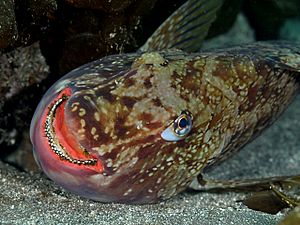Japanese parrotfish facts for kids
Quick facts for kids Japanese parrotfish |
|
|---|---|
 |
|
| Conservation status | |
| Scientific classification | |
| Synonyms | |
|
The Calotomus japonicus, also known as the Japanese parrotfish, is a type of parrotfish. You can find this fish in the northwest Pacific Ocean. It is quite common in its natural home.
Experts at the IUCN have looked at this fish. They have decided that it is a species of Least Concern. This means it is not currently in danger of disappearing.
Where Does the Japanese Parrotfish Live?
The Japanese parrotfish lives in the northwest Pacific Ocean. This includes areas near southern Japan, South Korea, and Taiwan.
For a while, people thought this fish also lived around northwest Hawaii. But later, scientists found out that those fish were a different kind of parrotfish, called C. zonarcha.
Since the Japanese parrotfish is common, it faces no big threats. Because of this, the IUCN says it is a "Least Concern" species. However, in southern Japan and sometimes Taiwan, people often catch and sell this fish. They usually use gill nets to catch them.
These fish mostly live near the coast. They like to swim in places where there is a lot of seaweed and rocks.
What Does the Japanese Parrotfish Look Like?
The Japanese parrotfish has a body that is a reddish-brown color. It also has white and light gray spots all over it. The part of its eye called the iris is yellow. It has a dark brown spot on its iris.
Male Japanese parrotfish are usually about 26.5 to 34.5 centimeters (10.4 to 13.6 inches) long. Female fish are a bit smaller, typically 20.2 to 26.0 centimeters (8.0 to 10.2 inches) long. The longest one ever found was about 39 centimeters (15.4 inches) long.
This fish is a protogynous hermaphrodite. This means it starts its life as a female and can change into a male later. They are also pelagic spawners. This means they release their eggs and sperm into the open water. The eggs then float and develop there.
See also
 In Spanish: Calotomus japonicus para niños
In Spanish: Calotomus japonicus para niños


